Introduction
Overall Design
{{section_header}}{{section.name}}{{/section_header}}
The {{product.name}} has a fairly uninspiring design, looking virtually identical to every other budget Vizio on the market in the 2011 model year. With a thick and glossy bezel, you will accumulate fingerprints like you were trying to hoard them. Normally, this would be an issue worth monitoring, but the {{product.model}} really isn't much of a looker anyways, so you may not care too much about this.
Front
{{section_header}}{{section.name}}{{/section_header}}

Back
{{section_header}}{{section.name}}{{/section_header}}

Sides
{{section_header}}{{section.name}}{{/section_header}}

Stand/Mount
{{section_header}}{{section.name}}{{/section_header}}
The plastic stand of the {{product.name}}, pictured below, has the same high-gloss finish on it as the bezel of the {{product.model}}. Frustratingly enough, the stand of the {{product.model}} is also stationary, meaning any changes to your cable setup are going to be a giant pain when you try to reach the back of your set.

Controls
{{section_header}}{{section.name}}{{/section_header}}
On the right side of the set in the back are the physical controls, which are not exactly easy to distinguish by touch, but over time you'll learn the positions of the major functions. It is somewhat of a pain to go hunting for the correct function in the dark, however.

Remote Control
{{section_header}}{{section.name}}{{/section_header}}
Despite the aesthetic shortcomings of the {{product.name}}, there is a bright spot in our tour, and that is the remote. With an updated design and increased functionality over last years' generation of Vizio remotes, that of the {{product.model}} is truly a sight to behold.

Though it's not the easiest thing to hold, it packs a lot of functionality into a small space, and it allows you access to some of the most commonly-used internet applications right at the top of the brick. If you thought that's all, there's more to come: the back of the remote features a full QWERTY keyboard and d-pad to allow you to take command of the internet apps and widgets more effectively. We haven't quite figured out why yet, but there's also another control pad that resembles the right half of a Super Nintendo controller.

In the Box
{{section_header}}{{section.name}}{{/section_header}}
Aside from the expected television, included in the packaging for the {{product.name}} is a cleaning cloth, batteries, remote, assorted documentation, a stand, and a rather nifty screwdriver to assist in setup.

Black Level
{{section_header}}{{section.name}}{{/section_header}}
Usually, when we tell you that a TV has a good black level, we are looking for a reading below 0.10cd2, which goes a long way to helping its contrast score. Referring to the chart below, you can see that this is not the case with the {{product.name}}, as we recorded a deepest black level of 0.23cd/m2. This isn't a horrible result, but be aware that the {{product.name}} isn't going to compete with higher end models for picture performance. More on how we test black level.
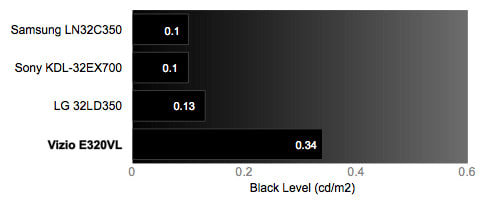
Peak Brightness
{{section_header}}{{section.name}}{{/section_header}}
Despite the minor shortcoming in its deepest blacks, the {{product.name}} does manage to have a decent peak brightness, even if that measurement isn't as important to contrast ratio. For reference, the Vizio's recorded peak brightness of 392.18cd/m2 is far above the minimum level needed to watch TV in a brightly lit room: around 200cd/m2. You will have no troubles watching your set in daylight. More on how we test peak brightness.
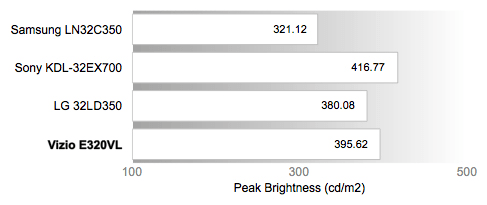
Contrast
{{section_header}}{{section.name}}{{/section_header}}
Due to its mediocre black level and its high peak brightness, the {{product.name}} manages to record a decent to fair contrast ratio of 1705:1. It won't give you the greatest level of detail in shadow, but new consumers may not notice any issues here. More on how we test contrast.

Tunnel Contrast
{{section_header}}{{section.name}}{{/section_header}}
Typically, LCD TVs don't do a bad job here, and the {{product.name}} is no different. No matter how much or how little area of the screen is occupied by black, the level remains more or less consistent. More on how we test tunnel contrast.
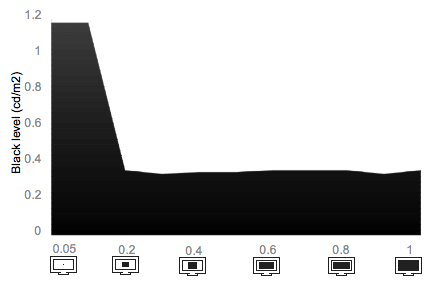
White Falloff
{{section_header}}{{section.name}}{{/section_header}}
We see the same result for white falloff too: no matter how much or how little area of white shows up on the screen, the brightness remains consistent. More on how we test white falloff.
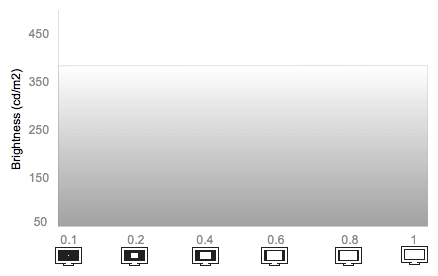
Uniformity
Greyscale Gamma
{{section_header}}{{section.name}}{{/section_header}}
When we test greyscale gamma, we look at two aspects of our charts before scoring a TV’s performance: the smoothness and slope of the line. The smoothness of the line tells us whether or not there were certain values of signal intensity that the TV simply couldn’t produce, or if they were produced incorrectly. Ideally, the slope of the line should lie somewhere between 2.1 and 2.2, but depending on a TV’s performance, this may vary. If it does, that means it doesn’t quite produce the ideal values along the greyscale, which can result in lost detail, especially in shadows.
In particular, the {{product.name}} doesn't seem to have any smoothness issues in its response graph, but it does have a rather steep slope of 2.58. Users with Superman-like visual acuity may notice some incorrect brightness values in shadows, or inconsistencies in brightness levels. More on how we test greyscale gamma.
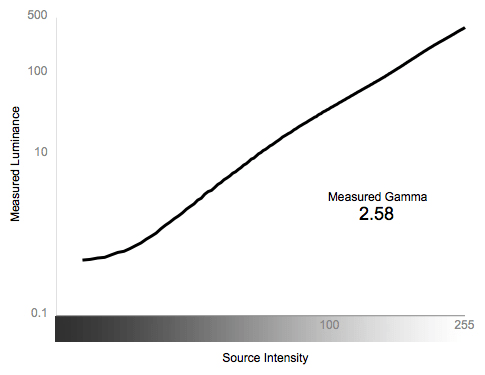
Color Temperature
{{section_header}}{{section.name}}{{/section_header}}
Here is an area in which the {{product.name}} impresses, as the recorded color temperature error never strays into the realm of human perceptibility. At no point along the entire range of signal intensity will you ever notice error in color temperature, even if you're looking for it. More on how we test color temperature.

RGB Curves
{{section_header}}{{section.name}}{{/section_header}}
Here too, the {{product.name}} does a great job at maintaining a consistently good performance: the RGB curves indicate no points at which the TV displayed incorrect color values, or color banding. There was a very tiny peaking problem towards the brightest end of the spectrum, but you will only notice that in the absolute brightest reds, blues and greens. More on how we test RGB curves.

Below you can see each of the color responses in linear format. Normally, if there were any errors, you would notice color banding in these strips. Observe!
Motion Performance
{{section_header}}{{section.name}}{{/section_header}}
The {{product.name}} offers a feature called Smooth Motion Effect. Known by other monikers on other manufacturer's TVs, they generally all do the same thing: insert new, interpolated frames between the original frames. Remember that video is really just a series of still images strung together and played fast enough to fool you that it's one continuous stream of motion. The idea is that if a TV can guess what the picture should look like between two of the original frames, it can manufacturer that image and slip it in between. The result is a smoother motion without the judder that you see on most LCD televisions, though it all depends on how well the TV can "guess" at those new frames it creates.
All in all, the {{product.name}} does a decent job, but not perfect. The overall effect is a smoother picture, though we noticed some flickering along high contrast borders. The edges of high contrast objects can also look a little ragged as they move across the screen. Straight, vertical lines also appeared to slant horizontally.
It's important to note that the Smooth Motion Effect should not be enabled for all types of content. Some content, especially anything shot on film, requires a certain amount of blur to make it look natural. If you enable Smooth Motion Effect, the result is something that looks to sharp and too smooth, like a soap opera shot on camcorders. From the layman, we've heard it phrased as "Why does this video look weird?" The answer is simple: turn off the motion smoothing. More on how we test motion performance.
3:2 Pulldown & 24fps
{{section_header}}{{section.name}}{{/section_header}}
Like most current TVs, there isn't much to report here: though the {{product.name}} did have its fair share of stutters and judders, but nothing that will stick out like a sore thumb. The {{product.name}} handles film-based content as well as can be expected by a mid-range television set. More on how we test 3:2 pulldown and 24fps.
Resolution Scaling
{{section_header}}{{section.name}}{{/section_header}}
Though the {{product.name}} can display all standard NTSC resolutions, that doesn't exactly mean it can display all of them well. Below is a short overview of some of the issues we came across: More on how we test resolution scaling.
480p
While displaying 480p content, the {{product.model}} displayed slight overscan.
720p
The {{product.model}} had no major issues to report while displaying content in 720p.
1080p
There was some discoloration in high frequency patterns while displaying 1080p content.
Formats
{{section_header}}{{section.name}}{{/section_header}}
The {{product.name}} has a standard resolution of 1080p and can display all standard NTSC formats.
Viewing Angle
{{section_header}}{{section.name}}{{/section_header}}
Before we rip on the {{product.name}} for having a small viewing angle, we'd like to make sure that you're aware that LCD screens typically do not do well here. As you can see below, while plasma screens have an absurdly wide viewing angle, their LCD screened competitors are typically can't go beyond about 30 degrees away from the center of the screen without losing 50% of their contrast.
In the 2011 model year for televisions, we've seen a massive increase in LCD TVs that have newer types of display called in-plane switching displays, which technically increase the horizontal viewing angle, but drop screen brightness massively as you move farther away from the center of the screen. While it doesn't appear that the {{product.name}} has this type of display, it does decently enough here in terms of typical LCD performance.

Reflectance
{{section_header}}{{section.name}}{{/section_header}}
The {{product.name}} doesn't do so well in handling reflections, as it diffuses little light away from the user. When a bright light shines on the screen, you will notice a very distracting reflection pattern that tends to block out sections of your picture depending on their placement. Consequently, the {{product.name}} did not score so well in this aspect of our testing.
Video Processing
{{section_header}}{{section.name}}{{/section_header}}
The {{product.name}} has a handful of advanced video processing modes, some more helpful than others.
Calibration
{{section_header}}{{section.name}}{{/section_header}}
The {{product.name}} is relatively simple to calibrate, with most of its major setting living in the picture menu. There isn't a massive amount of additional video processing, which is a good thing for newer users: without a better picture from the instruction manual, it would be difficult to tell what settings would be ideal if you didn't already know what they did first.

All of our calibration is done in conjunction with the DisplayMate software.
](http://www.displaymate.com/)
Video Modes
{{section_header}}{{section.name}}{{/section_header}}
The {{product.name}} has a handful of video modes, each for a different intended viewing environment.
Connectivity
{{section_header}}{{section.name}}{{/section_header}}
On the back of the TV set, you will find the ports of the {{product.model}} split into two panels: a rear panel that houses all of the analog options, ethernet port, and audio output ports, with a side-facing input panel home to all of the HDMI and USB ports. It's not an amazing array of ports, but you should have absolutely no troubles if your external media sources all use HDMI as their primary output medium. Otherwise, you'll be stuck with the lone component input port on the back, which can get tedious to swap out if you have several older media sources like the Nintendo Wii.

On the plus side, the {{product.model}} has both analog and digital audio output ports, allowing you to use a home theater system to avoid using the mediocre speakers built into the unit itself. It's nice to have both of these options, giving your audio equipment a greater chance of working with your TV.
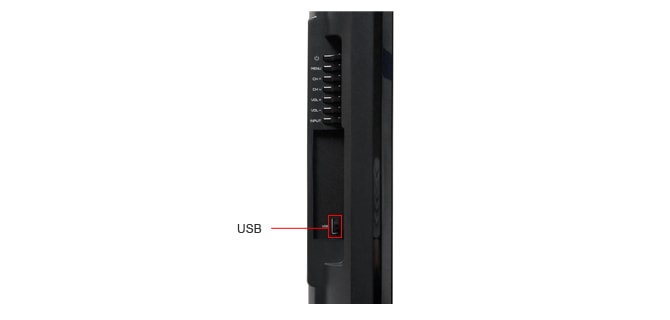
Placement
{{section_header}}{{section.name}}{{/section_header}}
The ports are split up on the back of the set, and while the panel that holds the analog and ethernet is a hassle, the side-facing input panel is quite nice, with easy access to the HDMI and USB ports. It's still worth mentioning that the ports on the back of the set are wretchedly difficult to access, but thankfully, the {{product.model}} is light. It will not take much force to physically move the set, as annoying as it may be to do so.
Audio Quality
{{section_header}}{{section.name}}{{/section_header}}
It doesn't take an audiophile to tell you that the sound that the {{product.name}} puts out is terrible. It's stunningly bad. This is probably why the TV has such good support for hooking up external sound systems, because we really wouldn't recommend using the {{product.model}}'s stock speakers.
Menu Interface
{{section_header}}{{section.name}}{{/section_header}}
When you press down on the menu button on the remote, you'll be taken to a launch screen that has icons for each different menu located on the side. It's not the most stunning thing in the world, but it is nice to see everything out on one page up-front.

From there, you can access the picture menu to alter your picture settings and advanced processing features, should you choose to do so. While this menu may not be the most beautiful thing in the world, it gets the job done.

Instruction Manual
{{section_header}}{{section.name}}{{/section_header}}
Vizio did a fairly good job at creating an informative instruction manual, but it leaves a few things to be desired. Notably missing from the document are page tabs, readable font, and a lengthy discussion about advanced features or attractive pages. It could have been better, but it gets the job done.

A manual for so many TV models, they have to be further categorized by type.
Internet Features
{{section_header}}{{section.name}}{{/section_header}}
When you see a slick remote with a full QWERTY keyboard and shortcut buttons, isn't that typically a good indication that there's probably going to be a browser? Especially when the manufacturer of your brand new TV set has hyped up the internet features available to you?
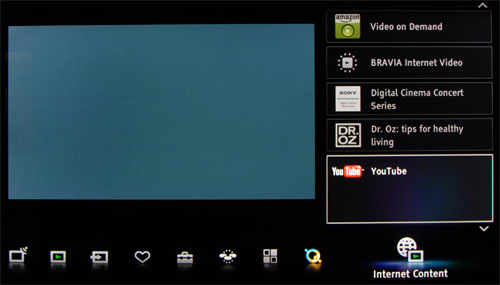
Sadly there is no browser available to users of the {{product.model}}. That's not to say that there isn't an absolute mountain of online features and applications to browse at your disposal, but so few outside of on-demand services and Twitter actually require or are helped by a QWERTY keyboard.
By pressing the large "V" button in the middle of the primary side of the remote, you call up a menu of internet applications and advanced features inaccessible through the main menu on the bottom of the screen. Once open, you can set up your DLNA settings, your streaming media account information, or even your Facebook profile.
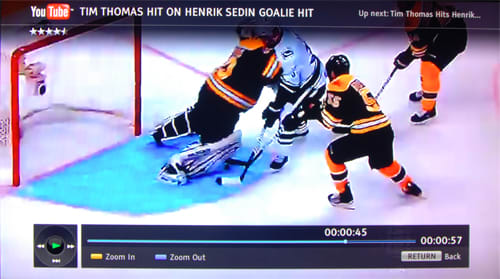
The YouTube playback is a wonderful thing.
"Free Streaming Web Videos" call up a list of video streaming clients that are, as you probably guessed, free to use. Strangely, there doesn't seem to be a YouTube application here. There is also a selection of Yahoo! web apps, but overall, these seem to be clunky and poorly programmed. If you really want to use these, you're probably best off using your computer for them.
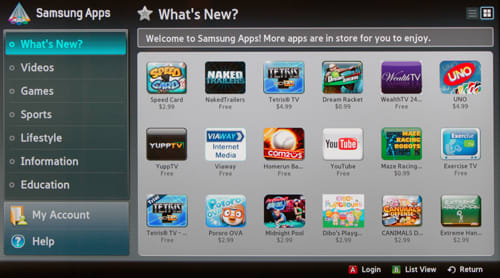
There are also plenty of games to download, free and paid, new and classic
Local Media Playback
{{section_header}}{{section.name}}{{/section_header}}
The {{product.name}} has two USB ports on the side, which allow you to port over your image, and music files to your new Vizio. While we don't recommend playing music on it without an external sound system, the slideshow function for images is decent. The interface looks like it was inspired somewhat by a computer operating system, using icons instead of a list format.

The playback screen is fairly terrible. It doesn't really leave much out, but locking the entire screen to display nothing more than a progress bar and playback options is somewhat annoying if you wanted to view other media along with your music.
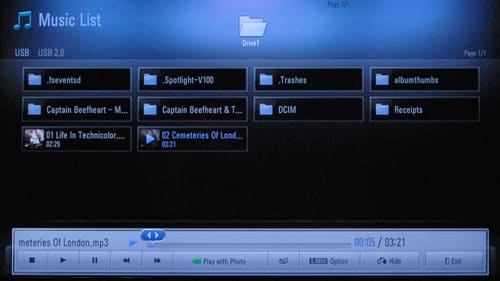
Other Media
{{section_header}}{{section.name}}{{/section_header}}
The {{product.name}} does not support any other type of media.
Power Consumption
{{section_header}}{{section.name}}{{/section_header}}
With LCD screens, you typically won't see any appreciable bump in your power bill, as they draw a very small amount of power even over extended periods of use. Not surprisingly, the {{product.name}} draws just over $13 a year with typical usage. Also, take note of how much more power the plasma screens draw over the same amount of time; though it's not going to break the bank, the more eco-conscious folk out there may want to pay attention to this statistic.
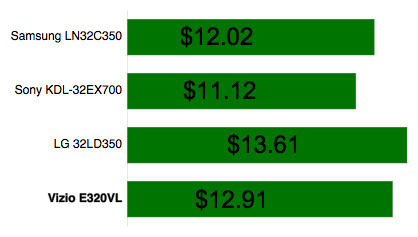
Value Comparison
{{section_header}}{{section.name}}{{/section_header}}
Between the {{product.name}} and the Samsung, its a little bit of an apples-and-oranges comparison, as for $300+ more dollars, you also get a far bigger plasma screen. Couple this with improved audio performance and connectivity options, and you see a very concrete gain for the extra money you'd spend on the Samsung over the Vizio.
Blacks & Whites
{{section_header}}{{section.name}}{{/section_header}}
Despite the fact that the Samsung recorded a lower deepest black in our labs, it also lacks a halfway decent peak brightness, which the Vizio does have. Though the contrast ratio for the Samsung is higher, the {{product.model}} will be able to be viewed in a well-lit room.

Color Accuracy
{{section_header}}{{section.name}}{{/section_header}}
The {{product.name}} has better color performance across the board here, recording less color temperature error, and better RGB curves.
Motion
{{section_header}}{{section.name}}{{/section_header}}
Both sets did fairly well here, and despite the full point difference between them, you probably won't notice any difference between either set in terms of motion performance.
Viewing Effects
{{section_header}}{{section.name}}{{/section_header}}
Because the Samsung set has a plasma screen, the viewing angle is far wider than that of the {{product.name}}. If you're looking for a set that can be seen from any angle, the Samsung is a better bet.
Connectivity
{{section_header}}{{section.name}}{{/section_header}}
With a wider array of ports and somewhat more intelligent placement, the Samsung nets a higher score here, but users of media sources that only use HDMI will probably not see much of a difference between the two sets.
Value Comparison
{{section_header}}{{section.name}}{{/section_header}}
With the extra $800 or so that you'd pay for the LG, you're not only getting a bigger screen by 5 inches, but you're also getting a massive array of online content from LG. It may not be worth it to you if you have an HTPC or other external media streaming device, but there are those who like a sleek, integrated system.
Blacks & Whites
{{section_header}}{{section.name}}{{/section_header}}
A clear win for the {{product.name}}, the LG falls short in deepest blacks, peak brightness and contrast ratio.

Color Accuracy
{{section_header}}{{section.name}}{{/section_header}}
Here too, the {{product.name}} beats the LG across the board, with lower color temperature error, higher RGB curve scores, and a better color gamut.
Motion
{{section_header}}{{section.name}}{{/section_header}}
Neither TV stunned us, but the {{product.name}} technically did better. Though the difference isn't immediately noticeable, the Vizio definitely performs better here.
Viewing Effects
{{section_header}}{{section.name}}{{/section_header}}
And again, the Vizio takes this matchup, even though it's a lot like saying who is king of the mole hill. By having a viewing angle that is 5 degrees wider on either side, the Vizio is the slightly better TV in this category.
Connectivity
{{section_header}}{{section.name}}{{/section_header}}
Here is where the LG absolutely beats the snot out of the {{product.name}}. While the Vizio does well in terms of raw performance, it lacks many analog options that the LG has more of, as well as lacking a bit in the streaming internet content department. If you like to stream media and browse on your TV, take a look at the LG.
Value Comparison
{{section_header}}{{section.name}}{{/section_header}}
For just over $200 less, the Panasonic TC-P42X3 offers a plasma screen with a huge viewing angle, competitive performance, and a slightly more attractive bezel. What you lose in cost, however, you also lose in connectivity ports. Though the {{product.name}} is about $200 more expensive, you get more connectivity options to hook up your external media sources, better color performance, and a screen brightness that will allow you to watch content more easily in a brightly-lit room or daytime.
Blacks & Whites
{{section_header}}{{section.name}}{{/section_header}}
The Panasonic has a much deeper black level than the {{product.model}}, and consequently a wider contrast ratio. It is worthy of note that the {{product.model}} has a much higher peak brightness, making it a better choice for users that view more TV during the day or in a brightly-lit room.

Color Accuracy
{{section_header}}{{section.name}}{{/section_header}}
Here, the {{product.model}} has better color performance on the whole, not only showing less perceptible color temperature error, but also better RGB curves.
Motion
{{section_header}}{{section.name}}{{/section_header}}
Both television sets handle motion content fairly well, although not perfectly. You will probably not notice much of a difference between the two side-by-side.
Viewing Effects
{{section_header}}{{section.name}}{{/section_header}}
As the Panasonic is a plasma screened TV, it has a far wider viewing angle than the {{product.model}}, allowing users to view from a wider variety of positions in the room containing the TV set.
Connectivity
{{section_header}}{{section.name}}{{/section_header}}
If you're looking to make your TV the main peice of your entertainment center, the {{product.model}} has double the HDMI ports, and more audio out options. Should you have multiple sources of content, you may want to consider the {{product.model}} over the Panasonic.
Conclusion
Overall, the {{product.name}} isn't a bad entry-level TV set for those looking for a TV with decent performance. For its price point, Vizio actually managed to give consumers a good buy with mid-range performance at an entry-level price, but it isn't without its shortcomings. In short: it's a very average TV set. It does what you ask of it, but it won't stun you or underwhelm you either. It's also important to think about what
Model Series Comparison
{{section_header}}{{section.name}}{{/section_header}}
The {{product.name}} is a member of the Mxx0SV series by Vizio, a family of LED-edgelit LCD screen TVs in the mid-range price point. Other models in the Mxx0SV series include the M470SV and the M550SV.
Photo Gallery
{{photo_gallery "Front Tour Image", "Back Tour Image", "Sides Tour Image", "Stand Photo", "Controls Photo", "Remote Control Photo", "Connectivity Tour Image 1", "Connectivity Tour Image 2", "Connectivity Extra Photo", "Menu Main Photo", "Menu 2 Photo", "Internet Features 1 Photo", "Internet Features 2 Photo", "Internet Features 3 Photo", "Local Media Playback 1 Photo", "Local Media Playback 2 Photo"}}
Ratings & Specs
{{manufacturer_specs_table}}
Meet the tester
A seasoned writer and professional photographer, Chris reviews cameras, headphones, smartphones, laptops, and lenses. Educated in Political Science and Linguistics, Chris can often be found building a robot army, snowboarding, or getting ink.
Checking our work.
Our team is here for one purpose: to help you buy the best stuff and love what you own. Our writers, editors, and lab technicians obsess over the products we cover to make sure you're confident and satisfied. Have a different opinion about something we recommend? Email us and we'll compare notes.
Shoot us an email
